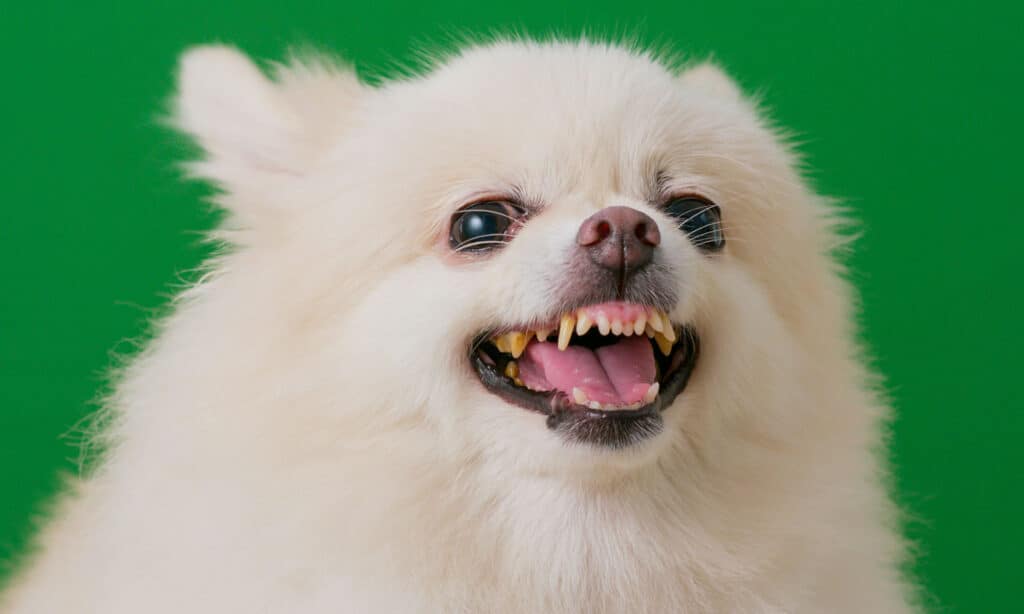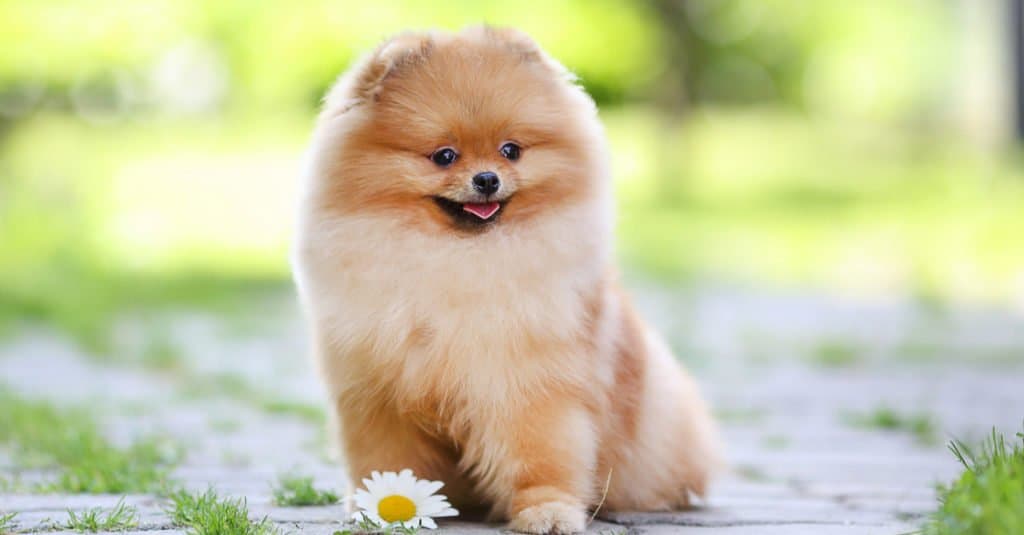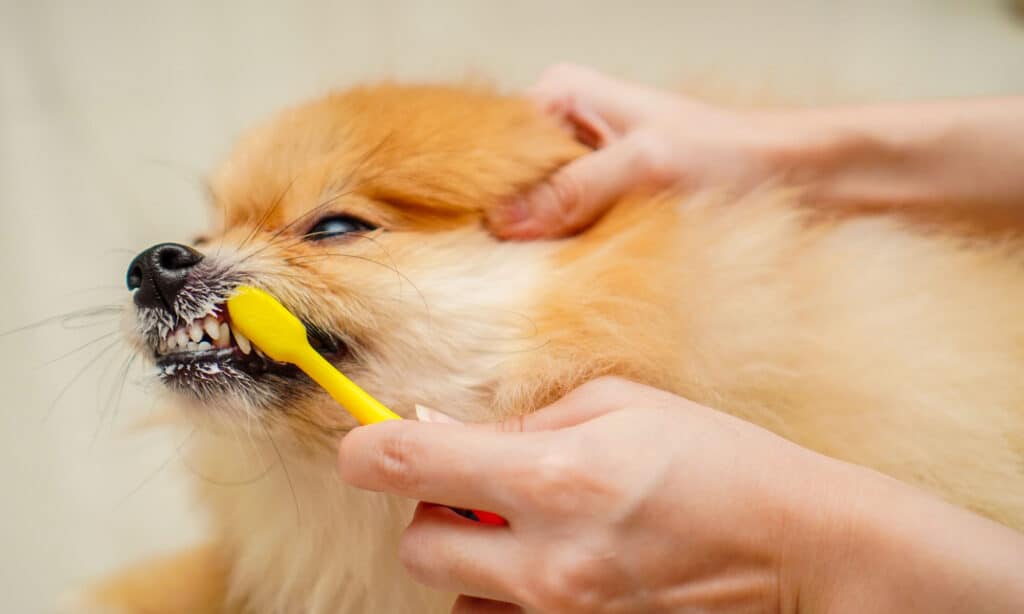Pomeranians are among the cutest dog breeds. They are perfect for homes as they are small enough to take anywhere and fluffy enough to cuddle with. The Pomeranian is a toy dog with a maximum weight of only seven pounds. The fact that their family tree diverges from terriers or other small breeds and originates from sled dogs is remarkable. Despite being fairly little, Pomeranians share genetic ancestry with giant sled dogs like the husky and Alaskan Malamute.
Nevertheless, they can capture anyone’s heart, whatever size they come in. If you recently became a proud owner of a Pomeranian puppy or you already have one, prioritizing your dog’s oral health is an important part of caring for it. Here’s everything you need to know about pomeranian teeth.
What Kind of Teeth Do Pomeranians Have?

Pomeranians have 42 teeth in total.
©leungchopan/Shutterstock.com
Inside their small mouths, Pomeranians have a total of 42 adult teeth. The top and bottom canines are much larger than premolars and molars, while the center area of the Pom’s mouth houses both the bottom and top incisors.
Pomeranian pups are born without teeth, but by the time they are six to eight weeks old, they develop 28 baby or deciduous teeth. They grow 42 teeth overall, comprising incisors (for grabbing), canines (for tearing), premolars, and molars (for grinding), which are present in adult Pomeranians.
Pomeranian Teething
Puppies of the Pomeranian breed are born without any teeth. Deciduous teeth are the first teeth that appear when a puppy is between six and eight weeks old (more commonly known as puppy teeth).
The second teething phase of the Pom puppy begins around the age of four months. If you observe Pomeranian teeth falling out, don’t get alarmed. The incisors begin to fall out so that adult teeth can fill the holes left by the deciduous ones. Yet, sometimes, baby teeth remain. This can be problematic since it can result in overcrowding in your dog’s mouth, making it difficult to maintain healthy, plaque-free teeth. Retained baby teeth are typical in Pomeranians, though this doesn’t always happen. It’s a good idea to have those teeth removed when this occurs.
The teething process for Pomeranian puppies often lasts for a few months. Your Pom may experience agony and extreme discomfort during this time. To help soothe their discomfort, puppies chew and bite more frequently, experimenting with various textures and objects.
When Do Pomeranians Stop Teething?

Pomeranian puppies stop teething when they are eight months old.
©Dulova Olga/Shutterstock.com
By the end of the eighth month, a Pomeranian puppy should have all 42 of its teeth. Poms frequently experience teething-related issues, and the Pom’s canine teeth are the most frequently preserved. To ensure your Pomeranian doesn’t have issues with its bite, have your veterinarian examine it when it’s three or four months old. It can be necessary to prematurely remove the baby teeth to prevent this.
Do Pomeranians Have Bad Teeth?

Pomeranians often have overcrowding and difficult-to-clean teeth.
©MRAORAOR/Shutterstock.com
In comparison to other breeds, Pomeranians typically have more dental issues. Because of their small jaws, Pomeranians often have overcrowding and difficult-to-clean teeth. Swollen gums can result from plaque and tartar buildup (gingivitis), which results in tooth decay and infection if left untreated.
The biggest threat to your Pomeranian’s teeth is dental disease. If your dog’s dental illness is serious enough, it may result in tooth decay, receding gums, and teeth that begin to come out. Your Pomeranian has a dental disease if you observe that its teeth are getting yellow, have brown spots on them, or are turning black close to the gum line.
The organs of your Pomeranian dog may suffer major harm if the tooth disease spreads far enough. Even worse, untreated dental issues can reduce the lifespan of your Pomeranian by up to three years.
Common Signs of Dental Problems in a Pomeranian
Periodontal disease in Pomeranians can lead to several problems, including discomfort, inflammation, foul breath, and tooth loss. Oral bacteria can affect the lungs, kidneys, and heart negatively. Fortunately, with the correct maintenance procedures, your Pom might keep his breath fresh and flash you that world-famous smile.
Some common signs of dental problems in a Pomeranian are listed below.
1. Weak or Broken Teeth
Shaky or broken teeth may result from neglecting your Pom’s teeth. Not only will this hurt, but it will also alter how your Pom consumes food.
2. Poor Breath
Bad breath indicates that your dog has periodontal disease or poor oral hygiene. Similar to humans, if plaque is not regularly removed from the teeth, it will begin to accumulate and eventually harden into tartar. While tartar is colorless, like plaque, it is noticeable as it is visible just above the gum line.
3. Blood in the Saliva
Your Pom may have gum disease if you notice blood in his saliva. The water bowl or chew toys of your Pom are two places where you might find the mixture of saliva and blood.
How to Care For a Pomeranian’s Teeth

©aonip/Shutterstock.com
Brushing is one of the best ways to look after a dog’s teeth. Plaque is eliminated while brushing, leaving little for gum disease-related germs to grow on. For this to be most successful, brushing must be done almost daily or every other day. This is because plaque accumulates within a day, hardens within two days, and becomes challenging to remove afterward.
Another useful strategy for maintaining the condition of your Pom’s teeth is to make them chew on bones. This is because chewing forces the plaque to become more easily dislodged and promotes healthy salivation.
Up Next:
Chameleon Teeth: Everything You Need To Know
Pomeranian Lifespan: How Long Do Pomeranians Live?
The Best Dog Food for Pomeranians for 2022
The photo featured at the top of this post is © Eva Sustar/Shutterstock.com
Ready to discover the top 10 cutest dog breeds in the entire world?
How about the fastest dogs, the largest dogs and those that are -- quite frankly -- just the kindest dogs on the planet? Each day, AZ Animals sends out lists just like this to our thousands of email subscribers. And the best part? It's FREE. Join today by entering your email below.
Sources
- Pomeranian HQ, Available here: https://pomeranian.org/pomeranian-teething/#:~:text=Pomeranians%20have%20premolars%20but%20not,puppy%20second%20teething%20phase%20commences
- Spinning Pom, Available here: https://spinningpom.com/pomeranian-teething/
- , Available here: https://dogsandclogs.com/do-pomeranians-have-bad-teeth/
Thank you for reading! Have some feedback for us? Contact the AZ Animals editorial team.







